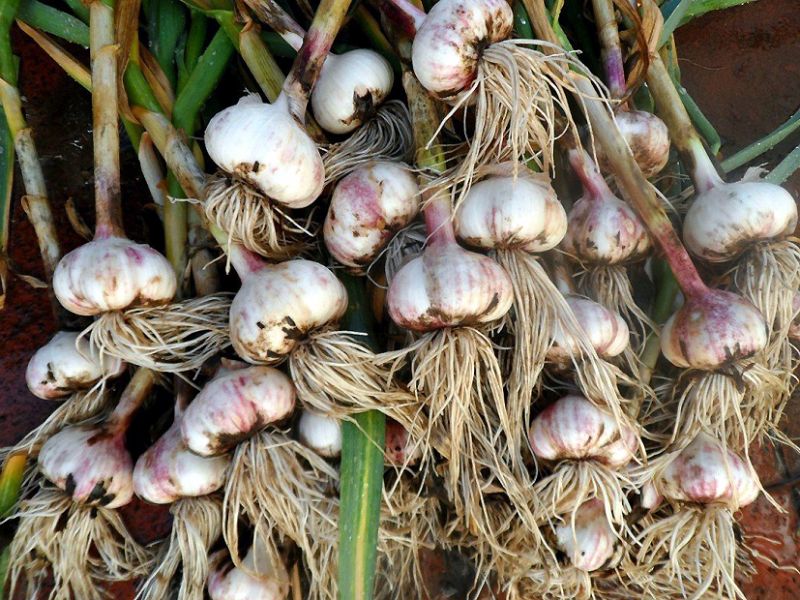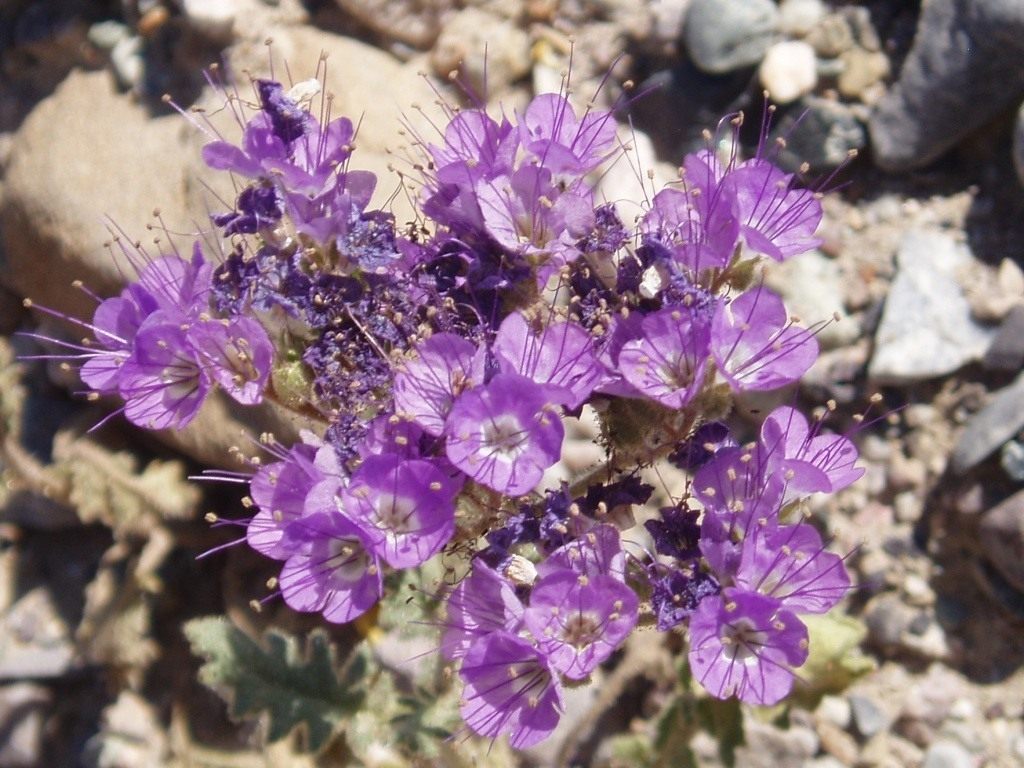Wildly growing in South and North America, the herbaceous perennial or annual phacelia plant belongs to the Burachnikov family. On garden and backyard plots it is used for landscape design, as honey plant and green manure. Growers are attracted by phacelia with their charming, blue-lilac-like bell-shaped flower. The plant blooms throughout the summer and attracts bees with its sweet scent.
Phacelia: general description, photo
Herbaceous plant with a height of 50 to 70 cm is distinguished by branched erect stems, which can be bristly hairy or pubescent. Large toothed or whole-edged leaves are arranged opposite or in the next order. For the most part they are pinnately dissected or lobed... Regular flowers with a bell-shaped, spike-shaped or tubular-bell-shaped corolla are formed on short pedicels. They are collected in spike-shaped inflorescences and can be white, purple, blue or dirty yellow in color. By the end of the growing season, a seed capsule-fruit is formed from the flowers.
Phacelia grows very quickly and builds up green mass, thereby protecting the soil from water and wind erosion, and suppressing the growth of weeds. The plant is undemanding to heat and can grow even on poor soils. Due to the short growing season of the flower, it can be sown three or four times per season. Phacelia can withstand frosts down to -9 C, therefore it grows and blooms from early spring to late autumn.
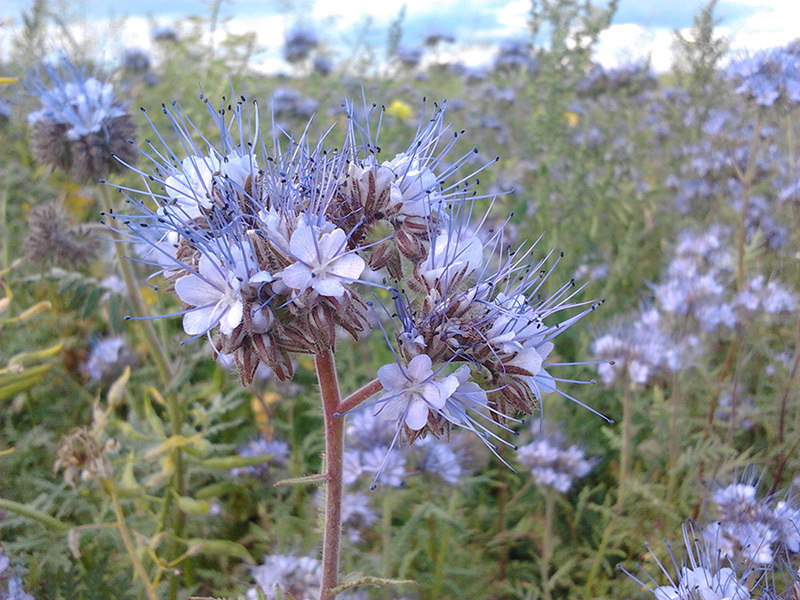
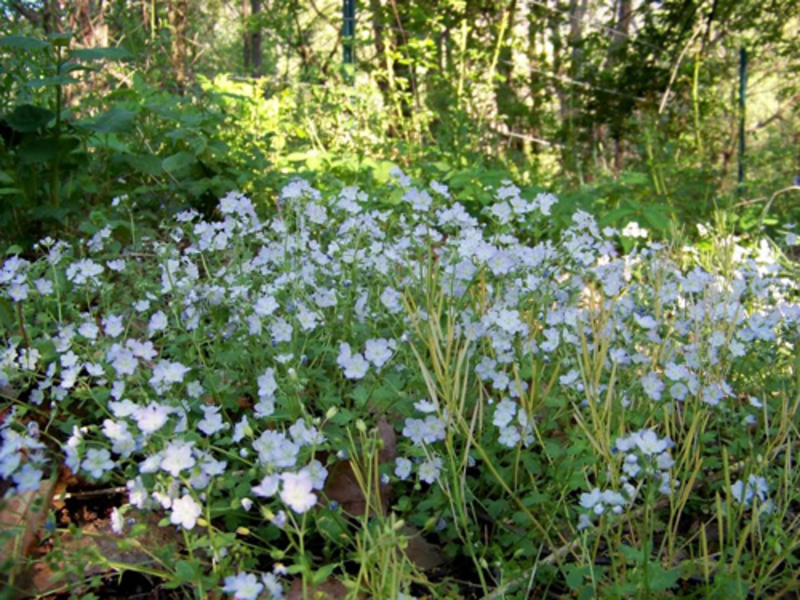


Phacelia species - photo
In nature there are more than 80 types this amazingly beautiful and useful flower. For cultivation in garden plots, only four are used:
- Phacelia is tansy. It is grown as an ornamental and agricultural crop. On shoots 50–100 cm long, modest bluish-gray flowers are formed, the diameter of which reaches 2 mm. Suitable growing conditions are well-lit areas with poor soils. In landscape design, it goes well with any flowering plants.
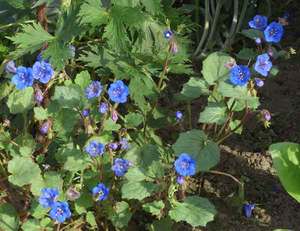 Phacelia Pursha. A delicate and vulnerable plant up to 50 cm high, it is distinguished by flowers, the corolla of which is mottled with purple spots on the outside, and pure white inside. The diameter of each flower is 3 cm. It grows well in sunny areas protected from the cold wind. Blooms profusely throughout the summer. One can distinguish the variety "Soft Lavender", the flowers of which have interesting colors. On their pale petals are scattered stripes and spots of different shades of blue.
Phacelia Pursha. A delicate and vulnerable plant up to 50 cm high, it is distinguished by flowers, the corolla of which is mottled with purple spots on the outside, and pure white inside. The diameter of each flower is 3 cm. It grows well in sunny areas protected from the cold wind. Blooms profusely throughout the summer. One can distinguish the variety "Soft Lavender", the flowers of which have interesting colors. On their pale petals are scattered stripes and spots of different shades of blue.- Phacelia is twisted. The plant is 50 cm high and has light green, soft, pubescent leaves and small flowers 5 mm in diameter. They are blue in color and, after wilting, form decorative seed pods. Flowers form in early June and bloom until frost. It develops poorly and looks insufficiently decorative in a rainy summer. Poorly tolerates the transplant. Serves to decorate flower beds, flower beds, borders.
- The phacelia is bell-shaped. An annual with reddish, fragile, erect stems reaches a height of 20-25 cm. Weak-lobed leaves up to 6 cm long on the shoots are arranged in the next order.They are distinguished by irregular teeth along the edge and a blue-green border with a brownish-red tint. Dark blue bell-shaped flowers up to 3 cm in diameter have dark spots at the base. They are collected in racemose inflorescences and bloom profusely for 30-40 days from mid-June.
Phacelia: features of cultivation, photo
The light-loving plant prefers well-lit areas and can grow on almost any soil. Sowing outdoors can be done throughout the season... It is possible to lay seeds in open ground in early spring even at a time when the last frosts have not passed. Even at subzero temperatures, seedlings appear and grow well.
Landing
When sowing seeds, you must follow some guidelines:
- The selected area is dug up and freed from weeds.
- The soil is leveled, lightly rolled and watered.
- The seed is mixed with dry fine sawdust or sand.
- Seeds are sown in grooves or simply scattered over the bed.
The first shoots will appear in 10-15 days, and the phacelia will bloom in a month.
Phacelia care
A drought-resistant plant does not like high moisture and stagnation of water in the soil. However, it must be watered abundantly and regularly. This is especially important during seed germination, as they will take a long time to germinate in dry soil.
 It is recommended to feed phacelia twice a season with complex mineral fertilizers. Without them, flowering may not be very abundant. The soil around the plant must be treated regularly. from weeds and sometimes loosen. Phacelia cannot be transplanted, so they must be immediately planted in a permanent place of growth.
It is recommended to feed phacelia twice a season with complex mineral fertilizers. Without them, flowering may not be very abundant. The soil around the plant must be treated regularly. from weeds and sometimes loosen. Phacelia cannot be transplanted, so they must be immediately planted in a permanent place of growth.
In order to collect planting material from a plant, it must be removed as soon as the seeds are ripe on the bottom of the inflorescence. If you wait for the seed pods to ripen on the top of the shoot, the lower ones will already overripe and crumble. While they are the larger and more complete.
At the end of flowering, the phacelia is mowed, crushed and buried in the ground. Thus, the soil on the site will be enriched with organic matter without any hassle and chemistry.
Phacelia in landscape design - photo
Most often, when decorating a garden plot, the plant is used:
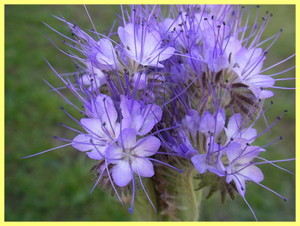 for decorating flower beds and flower beds;
for decorating flower beds and flower beds;- for decorating fruit and berry crops;
- undersized species decorate curbs, alpine slides and rockeries;
- plants planted in pots decorate gazebos and terraces;
- Phacelia looks very beautiful in a company with rudbecky, antirrinum and calendula.
Phacelia - honey plant
The plant is very much appreciated for its early maturity and the fact that bees love it very much. Phacelia is an excellent honey plant. Its honey is highly prized for its medicinal properties and unusual aroma. Up to 5 mg of nectar is collected from one flower, which contains up to 60% sugar in its natural form. Bees pollinate phacelia even after sunset.
Slightly tart honey has no hue at all or may be slightly dark green. It is peculiar to him preservation of healing qualities and original tastes for a long time. It crystallizes very slowly. Phacelia honey can be used to treat various diseases.
Perennial or annual phacelia can be grown both in the garden and in the vegetable garden. She is not only atpaints the site, but also enriches the soil and will attract bees. At the same time, the plant simply propagates by seeds and is unpretentious in care.

